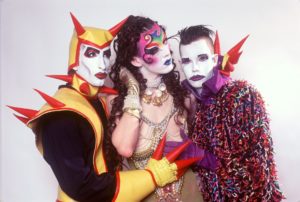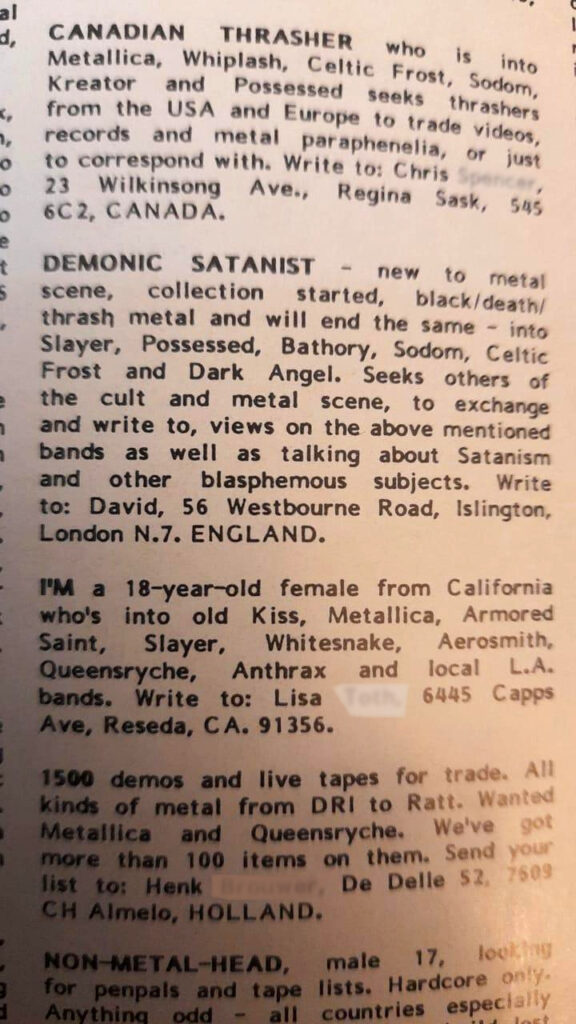*firstly, may change this title as it possibly sounds like I’m saying the opposite of what I’m saying*
That western culture¹ has issues with womens’ bodies² is not a new observation. But it feels like the issues are getting stranger. Recently there have been, both on TV (where the time of showing is important) and online (where it isn’t), cancer awareness campaigns where women who have had mastectomies are shown topless (in the daytime). This is definitely progress – but it simultaneously says two different things with very different implications.
On the one hand it’s – I would say obviously – very positive; it is of course normal to have a life-changing (or life saving) operation and the scars that come with it, and it can only be helpful to minimise the fear surrounding what is a daunting and scary prospect for millions of people. Normalising in the media things that are already within the normal experience of people – especially when those things have tended to be burdened with taboos – is generally the right thing to do. These scars, after all are nothing to be ashamed of or that should be glossed over or hidden from view. I hope that not many people would argue with that. But at the same time, isn’t it also saying, ‘yes it’s completely normal and fine for a woman to be seen topless on daytime TV, or on popular social media sites, as long as she’s had her breasts³ cut off?’ That seems less positive to me.
¹ Western culture isn’t alone in this, but ‘write about what you know’ (not always good advice, but still). I’m also aware that this whole article could be seen as a plea for more nudity. I’m not sure that’s what I mean
² might as well say it, this article deals mainly with old fashioned binary distinctions, but misogyny applies equally to trans women and I think what I say about men probably applies equally to trans men.
³ or her nipples, on social media
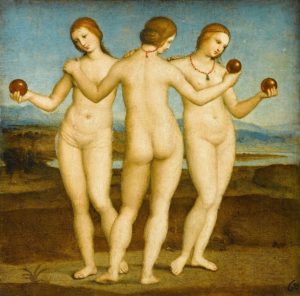
Essentially, this positive and enlightened development seems to be inadvertently(?) reinforcing ancient and (surely!) redundant arguments, in a completely confused way. ‘Non-sexual nudity’, whatever that means, has always been okay with the establishment(s) in some circumstances. Now, one could argue from the context (cancer awareness campaign) that the nudity is desexualised, and I think that’s why it is allowed to be aired at any time of day. In fact, the Ofcom (UK TV regulating authority) rules on nudity – which are aimed at ‘protecting the under 18s’ from nudity, a strange a concept, as it always has been*, are pretty simple:
Nudity
1.21: Nudity before the watershed [9 pm in the UK], or when content is likely to be accessed by children […] must be justified by the context.
*Interestingly, Ofcom’s rules about nudity are listed between their rules about ‘Sexual behaviour’ and their rules about ‘Exorcism, the occult and the paranormal’
So presumably, Ofcom (rightly) considers this context to be justified, because the naked body is not being presented in a sexual context. But, at the same time, one thing the cancer awareness film demonstrates – and which I think it’s partly supposed to demonstrate – is that there’s nothing undesirable about the female body post-mastectomy. I mean, possibly that’s just me, projecting the notorious male gaze onto the subject, as if that’s the determining factor in what attractiveness is or isn’t, but let’s ignore that. Of course, the people that devised and created the film are not the same people that determine what can be shown on TV or online and when, but they would surely have been aware of the rules that they are working within.
Even accepting that it’s permitted to show a topless woman on TV during the daytime because it’s ‘de-sexualised nudity’, why is that better? Two opposing sides of that argument, a puritanical, right-wing one and a feminist one might both be (rightly?) skeptical of me, as a heterosexual male writing about this. But if women have to be de-sexualised to be regarded equally, or taken seriously, to not be somehow reduced by the male gaze (or damaging to the child’s gaze, since nudity on TV tends to be fine after children’s standard bedtimes and on the internet is theoretically policed by child locks) then that seems no less problematic – and not even very different – from the traditional, paternalistic Western view which sees the Virgin Mary as the ultimate exemplar of female-kind. And if sex or desire is itself the problem then not allowing specifically female nudity is also, typically, reducing the visibility of women for what is in essence a problem of male behaviour.
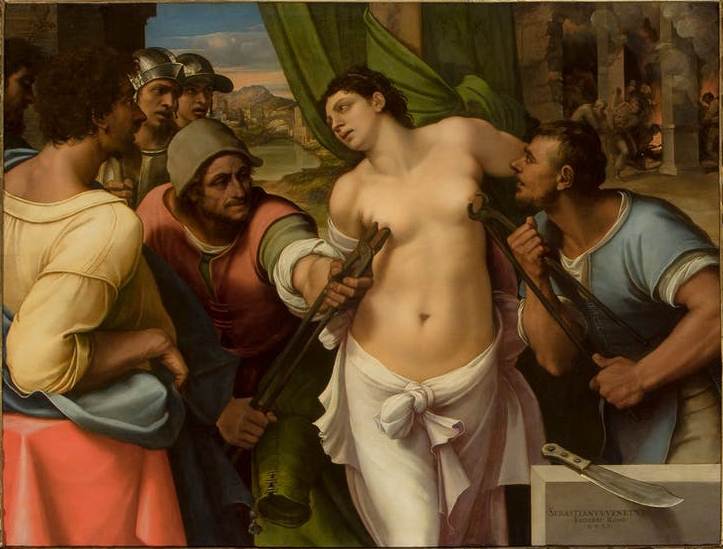
It’s worth looking at the fact that nudity is even an issue in the first place, considering that we all privately live with it, or in it, every day of our lives. In many world cultures of course, it isn’t and never has been a problem, unless/until Westerners have interfered with and poisoned those cultures, but it’s widespread enough elsewhere too, to be a human, rather than purely western quirk. It possibly has a little to do with climate, but it definitely has a lot to do with religion.
But the fact is that, in Western culture, even before the era of the Impressionists and their selectively nude women or the (as it now looks, very selectively) permissive society of the 1960s, female nudity has been perfectly acceptable to depict for hundreds of years; as long as the nude female is either mutilated (say, a virtuous martyr like the Roman suicide Lucretia), the victim of alien (non-Christian) assailants (various saints*) or, turning the tables, if she is a heathen herself (various classical figures, plus Biblical villains like Salome; a favourite subject with the same kind of sex & violence frisson as Lucretia)
* I didn’t realise when I posted this article that today (5th February) is the Feast day of St Agatha, the patron saint of – among other things – breast cancer. I’m not a believer in the supernatural or supreme beings, but that’s nice.
Even in Reformation Germany – surely one of the least frisky periods in the history of Western civilisation – in the private chambers of the privileged male viewer, nudity – especially female nudity – was there in abundance, providing it came with various kinds of extenuating nonsense; dressed up (or rather, not dressed up) in the trappings of classical antiquity. Okay, so maybe a woman can’t be flawless like Christ, but she can be nude and beautiful too, as long as she is being murdered, or stabbing herself to preserve her virtue, or is sentenced to everlasting damnation.
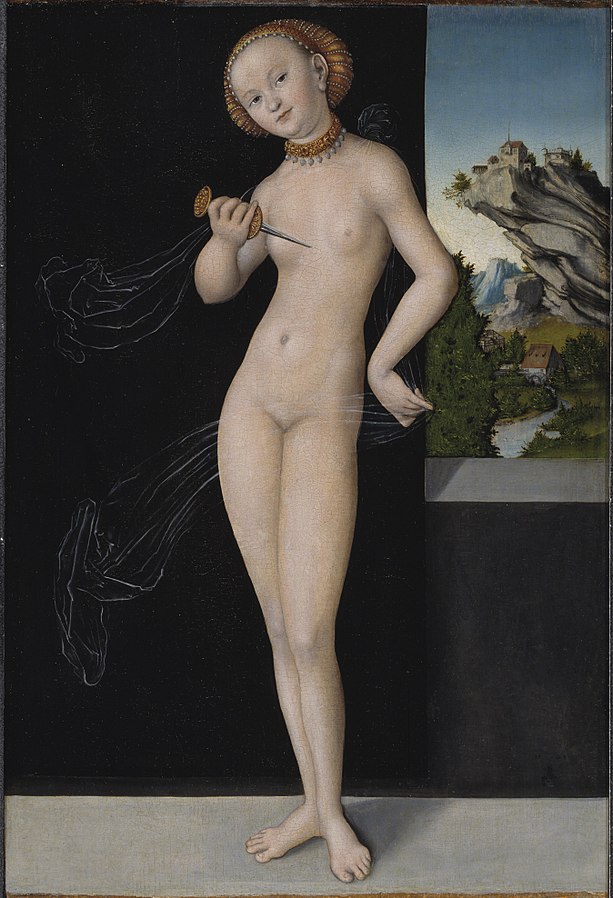
Men could, in art, and can on TV or anywhere else, be more or less naked (admittedly with a fig-leaf or something similar) at pretty much any time because – I assume – of Jesus. Otherwise how to explain it? The male chest is arguably less aesthetically pleasing than the female one, and certainly less utilitarian in the raising of infants, but in deciding that it is less sexual, our culture makes lots of assumptions and takes directives that come from religious, patriarchal roots.
The dissonance between the ways that female and male nudity are treated in our culture has its roots in Christianity and its iconography and although in the UK we’re technically the children of the Reformation, what’s striking is how little difference there really was between the way nudity was treated in the Catholic renaissance and the Protestant one.
In both Catholic and Protestant cultures, the art that was not solely designed for the private, adult (male) gaze was almost entirely religious. Popes and Puritans both found themselves in the same odd position; Jesus must be perfect and preferably therefore beautiful, whatever that meant at the time – but more than that, it would be blasphemous – literally criminal – not to portray Christ as beautiful.4 But in addition to being perfect, he must, crucially, be human. Understandably, but ironically, it seemed the obvious way to depict human beauty and perfection was without the burden of clothes. The human aspect is after all how the people of the Renaissance could (and I presume people still can) identify with Christ, in a way that they never do with God in other contexts, where that identification would be as blasphemous as a deliberately ugly Christ.
But how was one supposed to regard the nearly nude, technically beautiful body of Christ? With reverence, of course. But revering and worshipping the naked beautiful body of a perfect human being is not something that a misanthropic (or if that’s too strong, homo-skeptic5) religion can do lightly. Helpfully, the part of Christianity that puts the (nearly) naked figure at the centre of our attention is the human sacrifice ritual of the crucifixion and its aftermath. That bloody, pain-filled ritual allows the viewer to look at Jesus with pity and empathy and tempers (one would hope; but people) the quality of desire that the naked beautiful body of a perfect human being might be expected to engender. And to that Renaissance audience, the reason for that desire was another, but far more ambiguous subject for artists; Adam and Eve.
4 There are special cases though, see below re Grunewald
5 Doesn’t Alan Partridge call himself homoskeptic at some point? What I mean is – and I’m sure many Christians would take serious issue with this – that Christianity/the Christian God is in theory all-accepting of humans and their frailties, but somehow humans just as they are never seem to be quite good enough to escape negative judgement. Not just for things like murder or adultery that are within their power to not do, but things that are in their nature like envy and greed, and which were placed in their nature by God. And then, making a human being who must be killed for the things that other human beings have done or will by their nature do seems on the one hand, not very different from a horror movie pagan blood sacrifice cult and, on the other, kind of misanthropic
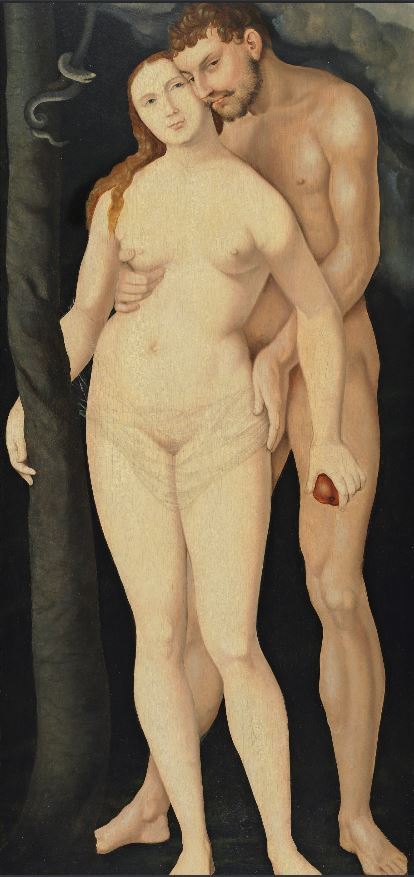
Adam and Eve were a gift to the Renaissance man seeking pervy thrills from his art collection because they are supposed to be sexy. Here are the first humans, made, like Christ, in God’s image and therefore outwardly perfect; and, to begin with, happily nude. But in (almost immediately) sullying the human body, Adam and Eve are fallible where Christ is not. But how to depict the people that brought us the concept of desire except as desirable? Because they are not only not our saviours, but the actual opposite, their nudity can afford to be alluring, as long as the lurking threat of that attraction is acknowledged.
Alongside the problems of the iconography in art came the practical problems of making it; and I think that one of the reasons that, of the four main ‘Turtles’ of the Italian Renaissance,6 Raphael was elevated to the status he enjoyed for centuries, is that his nude women suggested that he might actually have seen some nude women. For all their athletic/aesthetic beauty, figures like Michelangelo’s Night (see below) and his Sistine Chapel Sibyls are the product of someone who found that the church’s strictures on female nudity (no nude models) happened to strike a chord with his own ideas of aesthetic perfection. Likewise, Leonardo’s odd hybrid woman, the so-called Monna Vanna (possibly posed for by one of his male assistants) seems to demonstrate an uncharacteristic lack of curiosity on the artist’s part.
6 childish
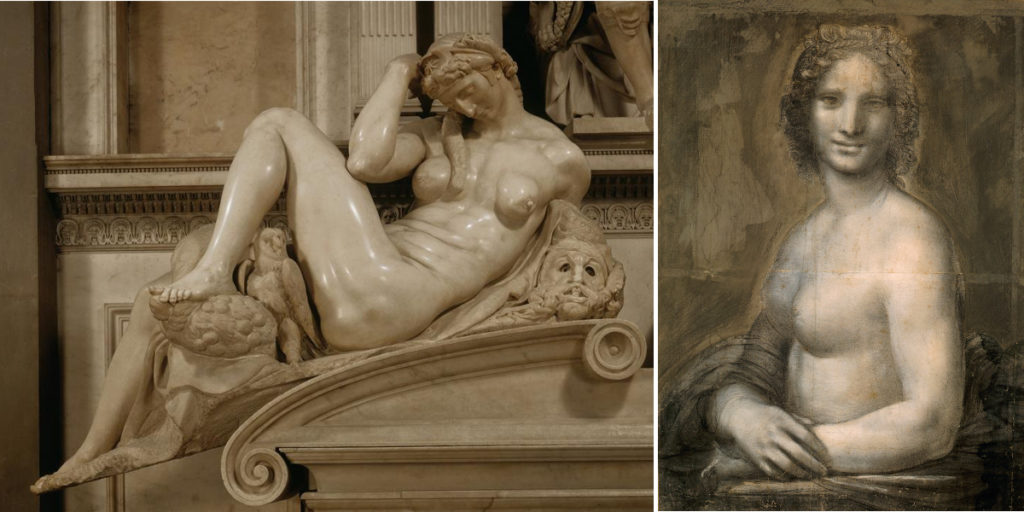
One way around the problem of naked human beauty was – as it seems still to be – to mutilate the body. Paintings like Mattias Grünewald’s agonised, diseased-looking Jesus (perhaps the most moving depiction of Christ, designed to give comfort and empathy to sufferers of skin diseases) and, on (mostly) a slightly shallower level, the myriad Italian paintings of the martyrdom of St Sebastian, do much the same as those Lucretias and St Agathas; they show the ideal of the body as god intended it, while punishing its perfection so that we can look at it without guilt.
This feels, for all its beauty, like the art of sickness. What kind of response these St Sebastians are supposed to evoke can only be guessed at; and the guesses are rarely ones the original owners of the paintings would have liked. Empathy with and reverence for the martyred saint, obviously; but while Grunewald’s Christ reflects and gives back this sense of shared humanity with the weight of his tortured body and his human suffering, St Sebastian gives us, what? Hope? Various kinds of spiritual (it’s in the eyes) and earthly (relaxed pose and suggestive loincloth) desire?
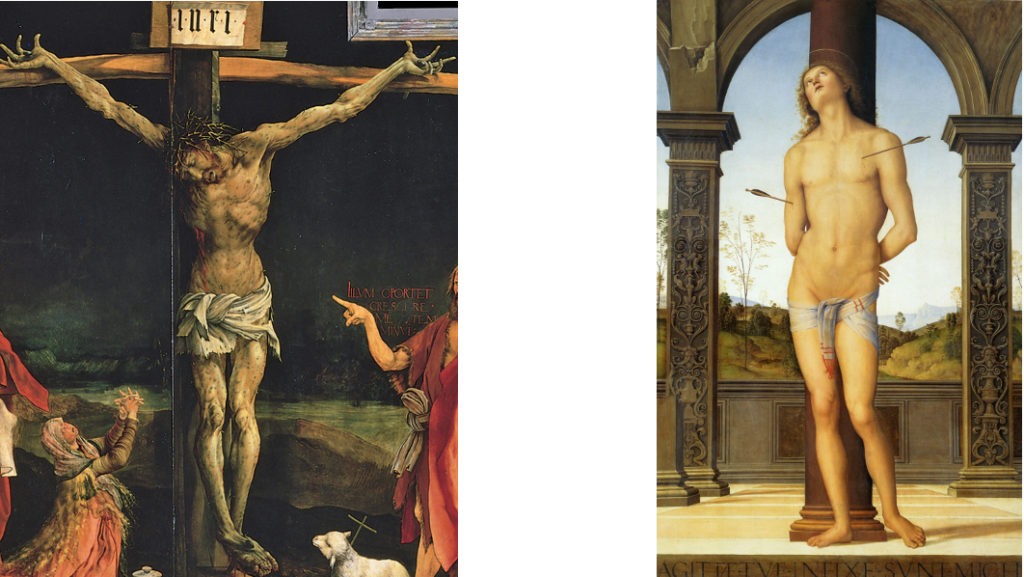
There are lots of fascinating themes and sub-themes here, but for now, there you have it; Christ may have, spiritually, redeemed all of humankind, but aesthetically speaking, women remain (as they say in Narnia) ‘daughters of Eve’.
Nowadays, tired presumably of the restrictions on their lives, men have liberated themselves enough that we don’t even need St Sebastian’s spiritual gaze, or a hint of damnation, to justify our nudity. In what remains an essentially patriarchal society, just advertising a razor, or underwear, or perfume, or chocolate, or taking part in a swimming event, or even just being outside on a warm day is enough to justify our bodies, as long as they don’t veer too far from that Christlike ideal, and as long as they aren’t visibly excited. But even now, women – who can look like humanity’s mother Eve, but not our reborn father Christ – can be more or less naked too, at any time of day they like (on TV or online at least); just as long as they are mutilated.



